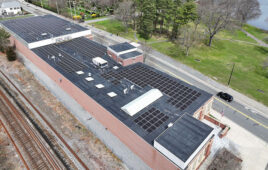
AgriSolar Clearinghouse
According to a review by the SUN DAY Campaign of data just released by the U.S. Energy Information Administration (EIA), renewable energy sources (i.e., biomass, geothermal, hydropower, solar, wind) provided almost a quarter of the nation’s electrical generation during the first two-thirds of 2022.
The latest issue of EIA’s “Electric Power Monthly” report (with data through August 31, 2022) reveals that in the first eight months of 2022, renewable energy sources (including small-scale solar systems) increased their electrical output by 17.5% compared to the same period a year earlier. Year-to-date, renewables have provided 23.3% of total U.S. electrical generation compared to 20.6% a year earlier.
For the eight-month period, electrical generation by wind increased by 22.0% and provided 10.0% of total electrical generation. Meanwhile, solar sources grew by 26.9% and provided 5.0% of the nation’s electrical output. In addition, generation by hydropower increased 10.5% and accounted for 6.7% of the total. Geothermal also grew by 0.7% while electrical generation attributed to the combination of wood and other biomass dropped by 2.1%.
Taken together, during the first two-thirds of 2022, renewable energy sources comfortably out-produced both coal and nuclear power by 17.9% and 32.3% respectively. In fact, over the past half-decade, renewables have moved from fourth into second place while relegating coal and nuclear to third and fourth place.
Five years ago, coal’s share of the nation’s electrical generation was 30.3% while that of nuclear power was 19.6%. Now, their respective shares have dropped to 19.8% and 17.6%. Meanwhile, renewables’ share has expanded from 18.2% to 23.3%. Natural gas, however, has retained its lead (38.5%) among energy sources comprising the U.S. electrical mix.
“These latest statistics suggest that renewables may well be on track to surpass EIA’s forecast for renewables to provide 22% of U.S. electrical generation in 2022 and 24% in 2023,” noted the SUN DAY Campaign’s executive director Ken Bossong. “Bolstered by the Inflation Reduction Act, renewables’ share could easily surpass 25% by the end of next year.”
News item from the SUN DAY Campaign





I concur, with Solarman.
The amount of D.C. source power available is still low compared to the Nikola Tesla/Westinghouse designed and promoted grid of today. As one looks for technology to create better efficiency you can see much of the devices of today are actually running on grid A.C. being rectified into D.C. and switched into higher voltage and sometimes higher frequency A.C. to drive the appliance or device. Going to a D.C. backbone buss at the local building and using electronics to take that (standard) buss voltage to energy would allow simple solar PV to battery storage to D.C. buss to power the residence instead of multiple A.C. to D.C. to A.C. conversions from power plant to end user residential home. In another 100 years it may be proven Thomas Edison who picked D.C. early on is a better option when one moves the overhead to the homeowner instead of the IOU electric utility.